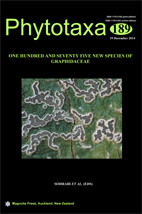Abstract
Descriptions and illustrations are provided for 20 new species in the family Graphidaceae (lichenized fungi) originating from El Salvador, the Guianas, Venezuela, Colombia, and Malaysia: Acanthothecis adjuncta Welz & Sipman, differing from all other Acanthothecis species by the rounded ascocarps with covered discs; Astrochapsa albella Sipman, differing from A. meridensis in the white apothecium rim, the corticolous growth habit, the more or less clear hymenium, and the protocetraric acid chemistry; A. columnaris Sipman, differing from other Astrochapsa species by the columnar marginal slips; Chapsa francisci Sipman, differing from other Chapsa species by the numerous marginal lacinae; C. nubila Sipman, differing from other Chapsa species by the combination of a guttulate hymenium and 4- to 8-spored asci; Diorygma extensum Sipman, differing from D. minisporum in producing norstictic acid instead of stictic acid; Fissurina chapsoides Sipman, a Fissurina species with large, muriform ascospores and short ascocarps opening mostly by branched slits; F. gigas Sipman, differing from F. rufula in the larger ascomata and muriform ascospores; F. vorax Sipman, differing from other Fissurina species by the aggregated ascocarps in combination with papillose paraphysis tips; Graphis murali-elegans Sipman, differing from G. elegans and G. lumbricina in the muriform ascospores; G. nigroglobosa Sipman, differing from G. mexicana in the absence of a complete thalline margin; Melanotrema comosum Sipman, a species of Melanotrema with extruding, clavate, brown hyphae on columella and excipulum; Myriochapsa annulata Sipman, differing from M. psoromica by the conspicuous, free excipulum; M. chocoensis Sipman, differing from M. psoromica in the smaller ascospores; Ocellularia pitalensis Sipman, differing from O. maxima by producing hypoprotocetraric acid; O. rugosa Sipman, similar to O. zamorana but with wider ostioles and 1-septate, pigmented ascospores with thick-walled juvenile stage; Thelotrema berendsohnii Sipman, similar to T. alboolivaceum, from which it differs by submuriform ascospores; T. kinabaluense Sipman, differing from other Thelotrema species by small, brown ascospores and protocetraric acid; T. paludosum Sipman, differing from other Thelotrema species by an inspersed hymenium, hypoprotocetraric acid and colorless, transversely septate ascospores of c. 30 × 7 µm; and T. parvisporum Sipman, differing from T. adjectum in the small, grey-brown ascospores.

